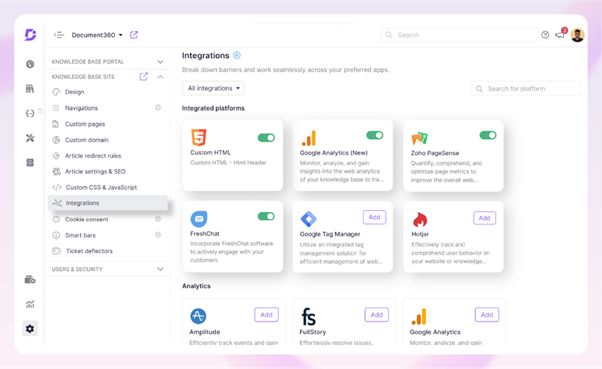Irrespective of the industry, documentation is the backbone of all businesses, including software development. IT documentation enables users (internal or external) to be able to comprehend your software and makes it easier for them to use it by including multimedia content such as video and audio.
It also lets your customers get more from your product, increasing retention and overall customer lifetime value.
But while it is essential, it can be cumbersome to create, manage, and update your IT documentation as it evolves, and share it with all your stakeholders. This is where DocOps comes in.
In this article, you will see how DocOps can streamline documentation to meet business needs and contribute directly to its success. We will discuss what it is, how it benefits your business, the key principles it works on, how you can implement it in your business, and what kind of platform to implement it.
So, let’s get started!
What is DocOps?
DocOps is the contemporary open-source approach to documentation. This means that all the documentation in your organization is available without any entry barriers to the whole team and even to the customers.
The main objective of DocOps is to enable all stakeholders to contribute their best to the documentation process. For example, engineers know how the API behaves better than anyone else, product owners understand customer needs better, and technical writers can optimize documentation in the best possible way. All these people should be able to contribute to these aspects of documentation at all times.
On the other hand, customers can also play a pivotal role in documentation if they can give feedback about the issues they notice in your documentation.
Making all this possible through automation and integrating the entire documentation process with operations, is DocOps.
Origins of DocOps
James Turcotte of CA Technologies introduced the term DocOps on LinkedIn in 2014. He emphasized the importance of business agility and the role of a dynamic content supply chain in that.
In his words, ‘DocOps is about creating a content supply chain that is collaborative, agile, and continuous.’
In a follow-up interview, he explained DocOps further with an example of how documentation works traditionally in tech companies. A team of writers publishes PDF/HTML documentation at the release date, and hundreds of support articles are published as bugs are encountered. The end customer has to search the original and the support articles to find answers to their queries.
With DocOps in place, CA technologies’ writers constantly “curate” content throughout the product’s lifecycle by fixing bugs within the original content. The content continues to mature throughout the product’s lifecycle, and customers can quickly find their answers within one document. The DocOps platform also uses analytics to reveal how well the content is meeting customer needs.
Keeping this in mind, let’s look at the benefits of DocOps in detail.
Benefits of DocOps
Collaborative authoring
As we discussed before, enabling users from different teams to contribute their knowledge in the development of content is the whole point of DocOps, and is called collaborative authoring.
One of its biggest benefits is that it emphasizes and enables collaboration and continuous document improvement through a dynamic content platform.
Multiple people work together to plan content, write it, test it, release it, analyze it, and then return to the source document to revise it. Some organizations may also have an unofficial DocOps team that meets at certain intervals to determine documentation needs and plan how to produce it in collaboration.
Breaking down silos
Like DevOps is a fusion between development and operations, DocOps is a fusion between documentation and operations.
So, one of the key benefits and purposes of DocOps is that it removes silos between these teams and allows content and software to develop hand-in-hand. It reflects the Agile methodology of project management that involves breaking the documentation development into phases while giving way for continuous collaboration and improvement.
DocOps allows free flow and exchange of information between teams so they can understand each other’s challenges better and work together to overcome them. With DocOps, teams learn from each other and co-create better outcomes.
Rapid customer feedback
DocOps views customer feedback as an integral part of content development.
Key Principles of DocOps
Continuous Documentation Flow
While Agile software development puts software before documentation, it does not devalue documentation per se. It simply encourages you to create documentation as the software is built instead of creating it before writing code. This forms one of the key principles of DocOps.
It only makes sense because your technical documentation must take the same approach as your software development, or you will never meet your documentation deadlines – quantitatively or qualitatively.
So, DocOps helps create a continuous agile documentation flow so you can successfully manage and deliver software projects along with the documentation.
Use of Cloud-based Collaborative Platforms
DocOps essentially means that your documentation must exist in one central hub where everyone can access it. This is the primary need for the documentation to be created, edited, managed, and shared by all teams.
Though the documentation can have selective access and can be version controlled, accessibility and manageability are the key, and a cloud-based platform makes it possible. So, generally, DocOps is a cloud-based knowledge base, but it can also be a DITA, CMS, or a wiki.
Whatever you use, you should be able to go back and make any changes in the documentation after the release of the software and the subsequent feedback from all parties. History tracking of the documentation becomes key here.
Integration with Agile Tools
Another key principle on which DocOps works well is that it integrates with your existing Agile tools, enabling information to flow freely within the system. Some popular Agile tools organizations use for various purposes are Jira, Trello, Asana, and Slack, but there can be many other technical ones, like Cucumber, Selenium, GitLaba, and more.
Choosing a tool or methodology that supports integration is the key feature to consider when implementing DocOps in your organization.
For example, Document360 integrates with 27+ apps and tools, including Slack, MS Teams, Freshdesk, Zendesk, Intercom, and Salesforce.

Data-driven documentation efforts
Another key principle of DocOps is that it uses analytics and reporting with the publishing platform to measure content performance. With DocOps, you can see if a piece of content is performing well if one is performing better than others, and how clients interact with the content.
This enables technical writers to manage content better, and organizations can make more data-driven and informed decisions. They come to know exactly what is working for the customers and what is not working for them and tweak their efforts accordingly, saving time and resources on unnecessary content.
Why DocOps is a Win-Win for Business?
DocOps is a game changer for businesses in more ways than one.
Traditional document management can be a tiresome process, especially when it comes to complex documents like technicals. With DocOps, you can implement standardized templates for document creation and categorization, minimizing the clutter in the process. Most importantly, with DocOps, you integrate documentation into the continuous delivery pipeline, which enhances the overall productivity of the content supply chain and its associated people. They can spend less time on administrative tasks and more time on innovative work.
With DocOps you can create automated workflows for repetitive tasks in your content pipeline, such as document formatting, version control, and compliance checks. This minimizes human intervention when it is not required, and teams can focus on tasks that require creative thinking.
Good DocOps tools come with not just templates but also advanced customization features. Companies can use this to create documents aligned with their brand styling and tone of voice. This brings consistency in the consumption experience at all touchpoints thereby creating brand integrity.
Poor document management can be more than an annoyance, it can cost you serious time and money because of security breaches, document errors, and even legal/ compliance issues. With DocOps, you can minimize such risks by:
- Controlling who can access, edit, share, delete, and store every piece of business documentation.
- Enforcing quality control protocols like standardized language
- Updating legal disclaimers and ensuring regulatory compliance
- Version controlling to prevent unauthorized changes while allowing updates to be applied uniformly across all documents, and more.
Implementing DocOps with the Right Platform
As elaborated earlier in the article, implementing DocOps can be a smooth experience with a cloud-based platform like Document360.
Tools like Document360 serve the key feature for DocOps: documentation centralization. When all your documentation is centralized in a repository, it facilitates easy collaboration, search, and update. While you will be categorizing and tagging your documents, a central portal is essential for a great user experience.
Some factors that you must consider while choosing the right tool for DocOps are:
- Ease of use: As with implementing any new process, your team will likely resist DocOps. So, you want to make the whole transition as easy as possible for your team. A solution like Document360 requires minimum technical knowledge and caters to different skill sets.
- Set up costs and licensing options: DocOps is easier to implement using a SaaS model, as it is a subscription model rather than expensive Desktop installations.
- Security features and compliance: Ensure that the platform you are using is compliant with security protocols and data privacy laws, such as HIPAA and GDPR.
- Support services: However easy the platform you choose, support is always required, especially during onboarding or technical troubleshooting. Choose a platform that offers such services and check customer reviews to validate them.
Best Practices of DocOps
Collaborative authoring
Implementing multiple contributors with different expertise adds more value to the documentation. At the same time, if it is not easy to collaborate, authoring will become chaotic. This involves real-time collaboration, tracking changes of each version and each contributor’s changes. This way, the documentation becomes more tightly integrated with product development.
Aligning documentation with software development sprints
The whole point of DocOps is to create a documentation system that runs along with software development.
For instance, as the world moves toward an application economy, apps are continuously developed and released. Content must keep up with this pace, as the market cannot afford to wait to release content until the app reaches the end of its development cycle. People need product information as it evolves, and only an agile approach like DocOps can deliver that.
Dynamic platforms that enable teams to collaborate and are built for continuous delivery automatically become the norm, and DocOps is the underlying process that facilitates this.
The platform you use for DocOps should also include features like automatic translation and AI-powered search for a superior experience and advanced analytics to facilitate data-backed decisions.
Self-sufficient tech for technical writers
Use the right authoring tools to create and manage the entire documentation life cycle. This reduces the dependency on the development team and others.
Platforms like Document360 with Markdown and advanced WYGSYW editors help the writers create, edit, preview, and publish articles its inbuilt version control helps you to track the changes. Also, writers have direct access to analytics where they see insights on user feedback and article performances helping them to make informed decisions.DocOps as a new standard for documentation management
To align content needs with fast-track software development like apps, DocOps is a must. DocOps provides an extremely agile documentation approach through a combination of collaboration, automation, continuous updation, and analytics.
The content is released as the software develops and is available at each phase of development, at the time of product release, and even after the product release. No wonder DocOps is becoming the new standard for documentation management, as it gives the most space to the internal teams and the best customer experience regarding documentation.
Wrapping up
The content supply chain must suit the agile needs of your business and DocOps empowers you to do that.
I hope that after reading this article, you have a clear idea of DocOps, what it can do for your business, and how to implement it effectively.




 –
– 

